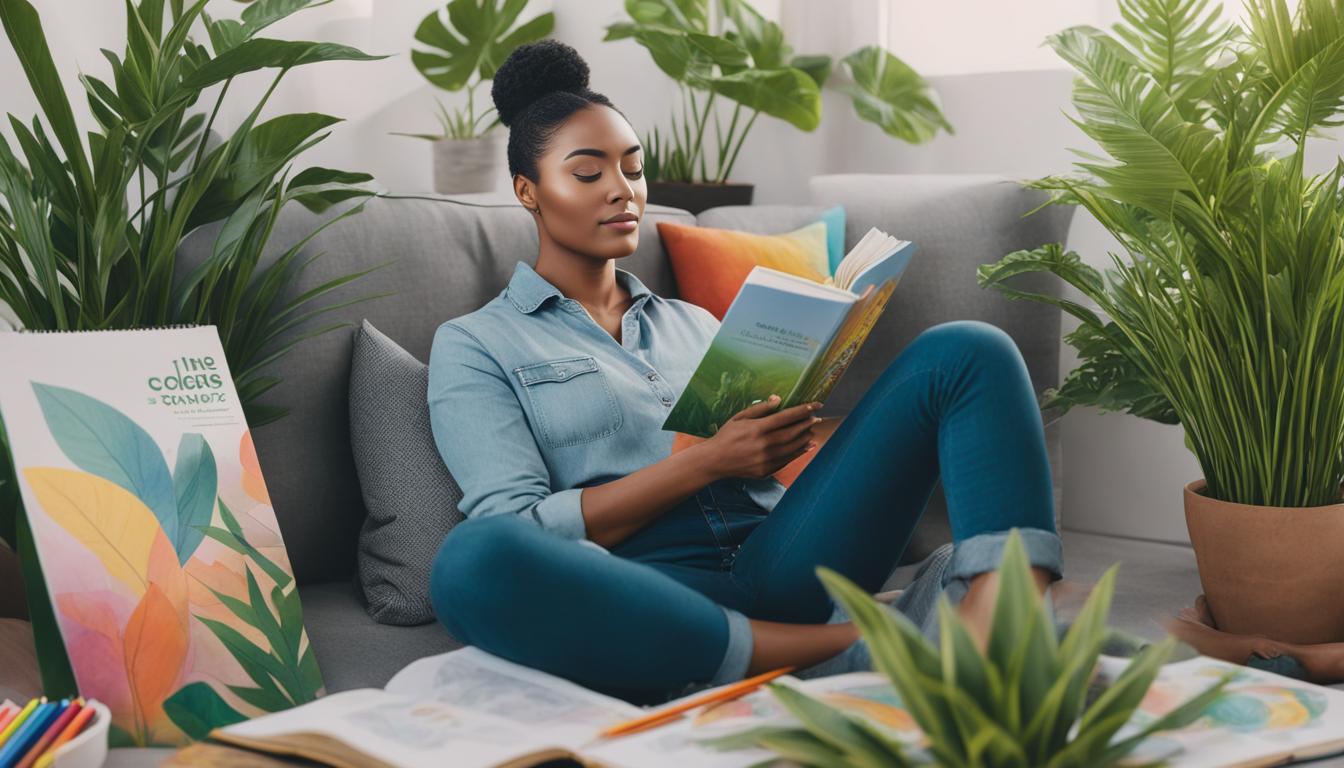
Coloring has become a popular and effective method for reducing stress and improving well-being. Combining coloring with mindfulness practices can further enhance its benefits. Mindful coloring involves paying close attention to the present moment without judgment, resulting in lowered anxiety and improved focus. Research has shown that this practice can have positive effects on university students, teachers, and individuals. Let’s explore the power of coloring for mindfulness and how it can be a valuable tool for relaxation and stress relief.
Key Takeaways:
- Coloring has emerged as an effective method for reducing stress and improving well-being.
- Mindful coloring involves paying close attention to the present moment without judgment.
- Research has shown that mindful coloring can lower anxiety and improve focus.
- Mindful coloring can be beneficial for children and adults alike.
- Combining coloring with mindfulness practices can enhance the relaxation and stress relief benefits.
The Benefits of Mindful Coloring
Mindful coloring offers numerous benefits that contribute to relaxation and well-being. It can help reduce anxiety and stress, improve focus and concentration, promote mindfulness and self-awareness, and stimulate creativity.
Coloring mindfully allows individuals to be fully present in the moment and let go of negative thoughts and distractions. It can serve as a form of meditation and a way to exercise mindfulness.
Engaging in mindful coloring activities can be a valuable relaxation technique and a means of self-expression.
| Benefits of Mindful Coloring | Description |
|---|---|
| Reduces anxiety and stress | Mindful coloring helps calm the mind and promotes a sense of relaxation, allowing individuals to manage their anxiety and stress levels effectively. |
| Improves focus and concentration | By engaging in mindful coloring, individuals can enhance their ability to concentrate on the present moment, improving their focus and attention span. |
| Promotes mindfulness and self-awareness | Mindful coloring encourages individuals to be fully present in the activity, fostering self-awareness and a deeper connection with one’s thoughts and emotions. |
| Stimulates creativity | Coloring mindfully allows for exploration and experimentation with colors, patterns, and designs, nurturing one’s creative abilities. |
Mindful coloring offers a holistic approach to relaxation and self-care, providing a creative outlet for emotional expression and promoting a sense of tranquility.
The Science Behind Mindful Coloring
Scientific research provides compelling evidence for the effectiveness of mindful coloring in stress management and overall well-being. Studies have shown that coloring activates the brain’s reward system, triggering a state of relaxation similar to meditation.
When we color mindfully, the two hemispheres of the brain engage in communication, promoting cognitive coordination and enhancing motor skills and vision. This coordination between brain hemispheres can have a profound impact on our ability to manage stress and enhance our overall well-being.
Furthermore, mindful coloring stimulates the release of melatonin, often referred to as the sleep hormone. This can result in better sleep quality, which plays a crucial role in maintaining our mental and physical health.
Therefore, mindful coloring can be considered a form of art therapy, harnessing the power of creativity and self-expression to promote relaxation and reduce stress. By engaging in this mindful practice, we can tap into the therapeutic benefits of art and channel our emotions in a positive and constructive way.
| Benefits of Mindful Coloring | Scientific Evidence |
|---|---|
| Reduces stress and anxiety | Research shows that coloring activates the brain’s reward system, inducing a state of relaxation. |
| Enhances focus and concentration | Mindful coloring requires attention and concentration, improving our ability to focus on the present moment. |
| Promotes self-awareness and mindfulness | Engaging in mindful coloring allows us to be fully present, observe our thoughts and emotions without judgment, and cultivate a state of mindfulness. |
| Stimulates creativity | Mindful coloring provides a space for creative expression and exploration, fostering our imagination and generating new ideas. |
Integrating Mindfulness with Coloring
Mindfulness can be seamlessly incorporated into the practice of coloring, enhancing its therapeutic benefits and promoting a deeper sense of relaxation and focus. By combining the principles of mindfulness with coloring techniques, individuals can experience a heightened level of presence and engagement in the creative process. Here are some effective ways to integrate mindfulness into your coloring practice:
Mindful Breathing
One technique to cultivate mindfulness while coloring is to focus on your breath. Take slow, deep breaths as you engage with the coloring activity, allowing each inhalation and exhalation to guide your movements. This conscious breathing helps to anchor your awareness in the present moment, enabling you to fully immerse yourself in the colors and patterns before you.
Non-Judgmental Awareness
Another approach to incorporating mindfulness into coloring is to observe your thoughts and emotions without judgment. As you color, notice any fleeting distractions or critical thoughts that arise, and simply let them go. Redirect your attention back to the soothing motion of coloring, embracing a non-judgmental mindset that allows for a more serene and peaceful experience.
“As I color mindfully, I let go of judgment and fully embrace the present moment. Each stroke of color becomes a form of self-expression and a pathway to inner calm.”
Mindfulness Coloring Books
Mindfulness coloring books are a valuable resource for those seeking guided instructions and prompts to deepen their mindful coloring practice. These books often feature intricate patterns and designs specifically tailored to promote relaxation, concentration, and stress relief. With the guidance of these books, individuals can effortlessly blend mindfulness techniques with the art of coloring, amplifying the therapeutic benefits.

The intricate patterns and designs found in mindfulness coloring books can help individuals enter a flow state that enhances relaxation and concentration.
By integrating mindfulness with coloring techniques, individuals can unlock the full potential of this therapeutic practice. The combination of mindfulness and coloring offers a powerful tool for relaxation, stress reduction, and self-expression. Whether you choose to focus on your breath, cultivate non-judgmental awareness, or utilize mindfulness coloring books, the key is to engage with the present moment and allow the act of coloring to become a meditative and calming experience.
Mindful Coloring for Different Audiences
Mindful coloring is a versatile practice suitable for individuals of all ages seeking stress relief and relaxation. Whether you’re an adult looking for a creative outlet or a student in need of a study break, coloring can be a valuable tool for improving well-being. Adult coloring books, in particular, have gained significant popularity due to their intricate designs and patterns that cater to coloring enthusiasts.
Coloring offers a therapeutic experience that can benefit multiple audiences. Teachers can use coloring as a relaxation technique to help manage the demands of their profession. Students, on the other hand, can utilize coloring as a means of self-expression and stress relief during exams or challenging academic periods. Individuals in high-stress professions can also find solace in the calming effects of mindful coloring.
I personally believe that the act of coloring mindfully can help reduce anxiety and improve focus and well-being. It’s a delightful way to disconnect from the digital world and reconnect with oneself.
Coloring has proven to be a versatile relaxation technique that transcends age and occupation. Whether you’re a parent seeking a bonding activity with your child or a working professional in need of a mental break, mindful coloring can help you find tranquility and express your creativity.
Tips for Mindful Coloring
To fully experience the benefits of mindful coloring, it is important to create a conducive environment. Here are some tips to help you make the most of your mindful coloring practice:
- Find a quiet and comfortable space: Choose a peaceful area where you can concentrate without distractions. It could be a cozy corner in your home or a tranquil spot outdoors.
- Use materials that enhance concentration: Opt for coloring tools that allow you to focus and immerse yourself in the activity. Colored pencils or markers with smooth, vibrant colors can enhance your experience.
- Select coloring pages that promote calmness: Look for images that resonate with you and evoke a sense of tranquility. Nature scenes, mandalas, or geometric patterns are often popular choices for mindful coloring.
- Focus on the process, not the outcome: Let go of any expectations or pressures to create a perfect masterpiece. Instead, focus on the act of coloring itself and the soothing sensation it brings.
- Embrace imperfections: Allow yourself to make mistakes and embrace imperfections. Remember that the goal of mindful coloring is not to produce flawless artwork, but to cultivate a state of relaxation and mindfulness.
- Observe your thoughts and emotions: As you color, pay attention to your thoughts and emotions without judgment. Notice how different colors and patterns make you feel and let any distracting thoughts gently pass by.
By incorporating these tips into your mindful coloring practice, you can enhance your relaxation experience and reap the full benefits of this therapeutic activity.
Engaging in mindful coloring can be a rejuvenating and creative way to reduce stress and promote well-being. Let the combination of color and mindfulness guide you towards a calmer and more centered state of mind.
Conclusion
Coloring for mindfulness is a powerful tool for relaxation, stress management, and overall well-being. By combining the therapeutic benefits of coloring with mindfulness practices, individuals can experience reduced anxiety, improved focus, and a greater sense of calmness. Whether using coloring books specifically designed for mindfulness or engaging in other mindful activities, such as coloring mandalas or nature scenes, the act of coloring can be integrated into daily routines as a form of self-care.
Art therapy has long been recognized for its positive effects on mental health, and mindful coloring is an accessible and enjoyable way to incorporate art into one’s self-care routine. Through the act of coloring, individuals can tap into their creativity, express their emotions, and find a sense of tranquility. The intricate patterns and designs found in adult coloring books provide a canvas for relaxation and self-expression.
Stress management is crucial in today’s fast-paced world, and coloring for mindfulness offers an effective and enjoyable technique. By staying present in the moment, focusing on the colors and strokes, and letting go of any distractions or perfectionism, individuals can experience a meditative state that promotes relaxation and stress relief. Whether you are a busy professional, a student, or simply looking for a way to unwind, mindful coloring can be a valuable tool in your self-care toolbox.
FAQ
What is mindful coloring?
Mindful coloring is a practice that combines coloring with mindfulness techniques. It involves paying close attention to the present moment without judgment, allowing individuals to let go of negative thoughts and distractions.
What are the benefits of mindful coloring?
Mindful coloring offers numerous benefits, including reduced anxiety and stress, improved focus and concentration, promotion of mindfulness and self-awareness, and stimulation of creativity.
Is there scientific evidence to support the effectiveness of mindful coloring?
Yes, scientific research has shown that coloring activates the brain’s reward system and induces a state of relaxation similar to meditation. It also stimulates the release of melatonin, the sleep hormone, leading to better sleep quality.
How can mindfulness be integrated with coloring?
Mindfulness can be incorporated into coloring through various techniques, such as practicing mindful breathing while coloring or observing thoughts and emotions without judgment.
Who can benefit from mindful coloring?
Mindful coloring is suitable for both adults and children. It can be beneficial for individuals of all ages looking for stress relief and relaxation, including teachers, students, and individuals in high-stress professions.
What tips can help enhance the mindful coloring experience?
To enhance the mindful coloring experience, it is important to find a quiet and comfortable space, use materials that allow concentration, focus on the process rather than the outcome, and observe thoughts and emotions while coloring.
What is the significance of mindful coloring for relaxation?
Mindful coloring is a powerful tool for relaxation, stress relief, and overall well-being. It combines the benefits of coloring and mindfulness practices to promote a sense of calmness and creative expression.
